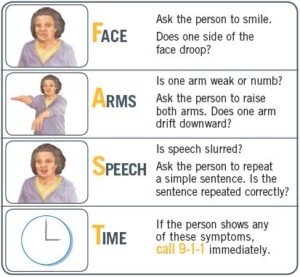Sudden Blurred Vision: Brain Aneurysm or What Else?
Sudden blurred vision that doesn’t go away can be caused by a brain aneurysm or a few other serious problems.
“Visual impairment may be a result of a retinal detachment, which can present with a curtain or veil-like effect covering one area of vision,” says Cindy P. Wang, O.D., F.A.A.O., with South Pasadena Optometric Group. in CA.
“This is usually in one eye and needs to be evaluated immediately by a retinal specialist.”
Brain Aneurysm As Cause of Blurred Vision
“Symptoms of blurry vision may also be caused by a brain aneurysm, which are rare, but very serious,” says Dr. Wang.

Brain aneurysm bulge. Shutterstock/Romanova Natali
“This usually occurs in only one eye. An aneurysm is a ballooning in a section of the wall of a blood vessel.
“This can cause leakage into the eye, or compression of nearby structures, which can result in poor blood circulation.
“If you experience sudden double vision or headaches in combination with blurry vision, you should be seen by a neurologist.” And don’t waste a minute on this, either.
“Some patients find it helpful to keep a diary of their symptoms. This will help the optometrist to determine if you are indeed experiencing ocular migraines [which are benign] and not something more serious.
“Knowing whether you have any vascular diseases, or if anyone in your family has suffered from strokes or migraines, could contribute to your doctor’s diagnosis.”
Dr. Wang points out that ocular migraines usually occur in people under 40.
If you’re 40-plus, she says it’s important that your optometrist work with your primary care physician—or a neurologist—to rule out more serious conditions.
In addition to a brain aneurysm and detached retina, another serious cause of blurry vision is diabetes.
Dr. Wang says, “Diabetic patients with prolonged uncontrolled blood sugar levels may develop proliferative diabetic retinopathy where blood vessels in the eye begin to weaken and leak fluid.
“This can cause swelling in the eye that leads to blurry vision, and should be evaluated by an eye care provider.”
 Dr. Wang has an extensive background in refractive surgery co-management and in the treatment of eye diseases such as glaucoma, diabetic retinopathy and hypertensive retinopathy.
Dr. Wang has an extensive background in refractive surgery co-management and in the treatment of eye diseases such as glaucoma, diabetic retinopathy and hypertensive retinopathy.
 Lorra Garrick has been covering medical, fitness and cybersecurity topics for many years, having written thousands of articles for print magazines and websites, including as a ghostwriter. She’s also a former ACE-certified personal trainer.
Lorra Garrick has been covering medical, fitness and cybersecurity topics for many years, having written thousands of articles for print magazines and websites, including as a ghostwriter. She’s also a former ACE-certified personal trainer.
.
Top image: Shutterstock/Kichigin
3 Benign Causes of Temporary Blurry Vision

If you’ve developed blurred vision that differs from mere worsening eyesight, there are three benign causes, but these explanations don’t rule out more serious or life-threatening causes.
“A temporary visual disturbance or episode could be a symptom of many things,” begins Cindy P. Wang, O.D., F.A.A.O., with South Pasadena Optometric Group. in CA. “The most common and benign is dry eyes.
“Dry eyes are often caused by air quality, reduced blinking, poor tear film, medications or prolonged computer use.
“Using artificial tears, taking frequent breaks and adjusting the height of computers to be below eye level can alleviate the symptoms.”

Freepik.com
Dr. Wang continues, “Another common cause of blurred vision is eyestrain, which can be caused by prolonged near work with infrequent breaks.
“Symptoms of eyestrain include blurred vision, headaches, dry eyes and neck and shoulder pain.
“Symptoms should decrease after resting your eyes. Try looking 20 feet away for 20 seconds every 20 minutes.”
Third up for a benign cause is an ocular migraine, “a temporary visual disturbance such as an enlarging blind spot, flickering lights or zigzag lines,” says Dr. Wang.
“Ocular migraines can occur in one or both eyes and usually last for 15-20 minutes. They may or may not be followed by a headache.
“Ocular migraines are benign and do not require treatment, although it can mimic symptoms of more serious health conditions,” namely a transient ischemic attack, which is a medical emergency.
You shouldn’t try to self-diagnose between blurred vison from a benign ocular migraine and blurred vision from a TIA.
Better safe than sorry; see a doctor even if you think the cause is probably benign and especially if mitigation efforts don’t work.
Dr. Wang explains, “Ocular migraines usually occur in those under 40. If you are over 40, then it is important that your optometrist work with your primary care physician or neurologist to rule out conditions that are more serious.”
 Dr. Wang has an extensive background in refractive surgery co-management and in the treatment of eye diseases such as glaucoma, diabetic retinopathy and hypertensive retinopathy.
Dr. Wang has an extensive background in refractive surgery co-management and in the treatment of eye diseases such as glaucoma, diabetic retinopathy and hypertensive retinopathy.
 Lorra Garrick has been covering medical, fitness and cybersecurity topics for many years, having written thousands of articles for print magazines and websites, including as a ghostwriter. She’s also a former ACE-certified personal trainer.
Lorra Garrick has been covering medical, fitness and cybersecurity topics for many years, having written thousands of articles for print magazines and websites, including as a ghostwriter. She’s also a former ACE-certified personal trainer.
.
Top image: Shutterstock/mydegage
Sudden Temporary Blurry Vision: When to See Doctor

See a doctor ASAP if you have sudden but temporary blurred vision, as this can be a harbinger of an awful outcome.
There are many causes of blurry vision, but let’s get more specific:
Your vision suddenly — not gradually — becomes blurred, and this lasts only minutes, maybe even 30 seconds, and then everything is back to normal, as though nothing had happened.
This may deceive you into thinking nothing serious happened.
But most likely, something very sinister just did.
Sudden onset blurry vision that doesn’t last long can be caused by a transient blood clot in the brain.

A blood clot in the brain can cause sudden blurry vision. Shutterstock/solar22
Here is what Cindy P. Wang, O.D., F.A.A.O., with South Pasadena Optometric Group in CA.says about this:
“If the visual disturbances are similar to a slow dimming of vision or blacking out of vision, and it lasts for five to 10 minutes, then it is likely caused by a mini-stroke, also known as a transient ischemic attack (TIA).”
Though the visual problem, caused by a TIA, is sometimes described as dimming or fading out, it’s also possible for a TIA to specifically cause sudden blurred vision that’s only temporary (a TIA, by definition, is temporary).
It may last less than five minutes, too.
In fact, strokefoundation.com states that “sudden blurred or decreased vision in one or both eyes” is one possible symptom of a TIA.
Medical Emergency
If you experience a sudden onset of blurred vision, even in one eye, this is a medical emergency, “caused by, but not limited to, atherosclerosis, carotid artery stenosis, heart disease, hypertension and diabetes,” says Dr. Wang.
“In this case, you should see your primary care physician or neurologist as soon as possible, especially if accompanied by other symptoms such as headaches, scalp tenderness or fever, which may indicate an inflammatory cause of vision loss.”
Ideally, you should have someone drive you to the emergency room.
Immediate medical attention is extremely important, as TIAs are harbingers of future strokes.
Even if you ultimately are not diagnosed with a TIA, it’s always better to be safe than sorry.
About 30% of people who experience a TIA — regardless of the type of symptoms it caused — are at risk of having a stroke within the following 30 days.
These grim odds can be dramatically lessened if there is immediate intervention and hence, management of the disease process that led to the transient ischemic attack in the first place.
Below is the “FAST” guide for identifying a TIA or a stroke.

Never blow off a sudden experience of blurred vision, no matter how brief.
If you’ve had a transient ischemic attack, it means there’s likely a partially blocked artery leading to your brain or a clot source in the heart.
 Dr. Wang has an extensive background in refractive surgery co-management and in the treatment of eye diseases such as glaucoma, diabetic retinopathy and hypertensive retinopathy.
Dr. Wang has an extensive background in refractive surgery co-management and in the treatment of eye diseases such as glaucoma, diabetic retinopathy and hypertensive retinopathy.
 Lorra Garrick has been covering medical, fitness and cybersecurity topics for many years, having written thousands of articles for print magazines and websites, including as a ghostwriter. She’s also a former ACE-certified personal trainer.
Lorra Garrick has been covering medical, fitness and cybersecurity topics for many years, having written thousands of articles for print magazines and websites, including as a ghostwriter. She’s also a former ACE-certified personal trainer.
Top image: Shutterstock/Roman Zaiets
Sources: str.okefoundation.com.au/what-is-a-stroke/types-of-stroke/transient-ischaemic-attack-tia/ umm.edu/health/medical/altmed/condition/transient-ischemic-attacks mayoclinic.org/diseases-conditions/stroke/symptoms-causes/dxc-20117265
Type of Teen Girl a Predator Won’t Try to Lure into a Car

Here are the traits of the kind of teen girl a predator would never try to lure into his car.
I am so sick of reading about teenaged girls who accept rides from strangers that I decided to write this article, featuring as my expert source, Carole Lieberman, MD, a forensic psychiatrist and author of Bad Boys: Why We Love Them, How to Live With Them and When to Leave Them.
This article specifically refers to girls who are not hitch hiking, but who, on the spot, are talked into accepting a ride from a stranger as they’re walking about in the community (I’ll save hitch hiking for another article).
We can be up all night debating what compelled, for instance, Amanda Berry to get into Ariel Castro’s car even though her perfectly working legs could have gotten her to her destination which was only a short distance away.
Let’s look at the flipside: What kind of teenaged girl would a predator never want to entice into his car?
What traits or features would this teen girl have to possess that would make the sex offender/killer cruise right past her as he drives around the neighborhood looking for a victim?
“Although a predator is not usually a genius, he is instinctually able to hone in on which girls would make the best victims,” begins Dr. Lieberman.
“As he follows behind them, scoping them out, he looks for signs that tell him who to choose as his prey and when to pounce.
“Even if he knows nothing more about them than their body language, how they’re dressed, how they look, what they’re carrying or doing, as they walk down the street, he can tell who would surrender to him more easily.
“The predator looks for signs of low self-esteem, loneliness and sadness. He asks himself, ‘Which girl feels neglected, disappointed by life, vulnerable to someone paying them attention, easily suggestible or too worn down to put up a fight?’”
It would be very intriguing if the following data could be unearthed:
The percentage of teen girls, who accepted a ride from a stranger (excluding hitch hikers), who were high achieving:
A-students, good athletes or heavy involvement in at least one sport, and involved in at least one other extracurricular activity, such as volunteer work, the school’s newspaper or the school drama club.
What percentage of these girls had NO idea what they wanted to do with their life after high school graduation? What percentage knew precisely what they wanted, having the plans all laid out?
Dr. Lieberman continues, “His best prey would be girls who walk slowly, dawdling, as if they’re not expected to be somewhere by anyone who cares. Girls who walk briskly with a sense of purpose would not make good prey.
“Girls who are dressed sloppily, or are poorly groomed, show that they don’t think much of themselves, are worn down and would be vulnerable to someone taking control.
“If she’s well-dressed (though not necessarily expensively), and well-coiffed, it tells a predator that she thinks too much of herself to be taken in by a stranger. If she’s dressed like a slut, it’s as though she’s wearing a neon sign that says,
‘Man wanted: please tell me I’m beautiful.’
“If a girl is carrying something heavy like a bag of groceries, it is easy for a predator to either offer to carry it or to snatch it away and make the girl follow him to get it.
“If she’s carrying a cell phone, it discourages a predator because he recognizes that it would be easy for her to call for help.”
A tough, strong minded teen may still be walking slowly and dressed sloppily—but be patient—I’ll get to that.
Dr. Lieberman explains, “Ariel Castro was skilled in choosing his prey. It was reported that, during his interrogation, he recalled each of the abductions in great detail and claimed that they were unplanned crimes of opportunity.
“In other words, he saw a girl who seemed like she was ripe for the picking.”
Amanda Berry was 16 and walking home from her Burger King job, and allegedly, she smiled at Castro in his van.
What was it about her that made him feel smug about lying to her that he was the father of one of her coworkers, and would she like a ride home?
“Although his specific lures were different, he sensed all three of these girls were vulnerable, as reflected by their apparent low self-esteem, loneliness and sadness,” says Dr. Lieberman, referring to Castro’s three victims.
“They were too disappointed by life to be more careful, especially when he chose the lure he believed would best appeal to each of them.”
Now back to the independent-minded, feisty teen who’s dawdling on her way home from school and wearing a T shirt and sweat pants. She could be an athlete with a sore hamstring.
She could be composing music inside her head or envisioning her performance for opening night of the school play.
The predator may see her as vulnerable and get as far as pulling his car alongside the curb and initiating conversation, such as, “Hello, where ya headed? I can give you a lift there on such a hot day.”
How would this girl respond that would make the predator speed away?
Obviously, if she whips out a whistle and blows it, or hollers “Fire! Fire!” he’ll burn rubber fleeing.
But aside from a very dramatic reaction, there are tamer responses and body language that would make him realize he picked the wrong victim.

Dr. Lieberman explains, “Once a perpetrator gets as far as offering a girl a ride, there are still traits that can make him back off.
“For example, if this mousey looking girl suddenly responds to him with a roar, such as, ‘Get away you [fill in the blank]!’ it would make him realize that he underestimated her.
“He would also be thrown off by her calling him out for what his is, a [fill in the blank].
“Similarly, if she scowls, straightens up, looks him in the eye, throws something at him or runs, he quickly realizes it’s too dangerous to keep pursuing her.”
If she calmly responds, “I don’t need a ride; my legs are pretty strong. In fact, my entire body is tough as nails,” and then stares at him hard, he will take off.
Of course, she must speak with conviction and pretend she’s the cat and he’s the mouse.
He will pick up on this instantly and, suddenly feeling frightened, will speed away, feeling like the mouse he truly is.
 Dr. Lieberman analyzes the psychological impact of world events, as a guest and/or host on all major media outlets. Her appearances include “Larry King Live,” “The Today Show,” “Good Morning America,” “Entertainment Tonight,” CNN and Fox News.
Dr. Lieberman analyzes the psychological impact of world events, as a guest and/or host on all major media outlets. Her appearances include “Larry King Live,” “The Today Show,” “Good Morning America,” “Entertainment Tonight,” CNN and Fox News.
 Lorra Garrick has been covering medical, fitness and cybersecurity topics for many years, having written thousands of articles for print magazines and websites, including as a ghostwriter. She’s also a former ACE-certified personal trainer.
Lorra Garrick has been covering medical, fitness and cybersecurity topics for many years, having written thousands of articles for print magazines and websites, including as a ghostwriter. She’s also a former ACE-certified personal trainer.
Do Asymmetrical Legs Mean ALS?

Are you panicking about ALS because your legs are uneven or not symmetrical?
The body is NOT symmetrical. This applies to more than shape and muscles. Examine the moles on your lower leg.
Do you have the exact same pattern of moles on your other leg? One calf is probably bigger than the other, too.
Gee, I see this ALL the time in someone walking ahead of me wearing shorts.
Like you have a dominant arm, you also have a dominant leg. There is no reason to worry about ALS.
The dominant leg may have more dents in the calf, reflecting slightly more toned muscles and/or less fat (not atrophy!).
As a former personal trainer, I’d see this all the time in my clients as well as other gym patrons.
If your less dominant calf has more dents, this does not mean muscle atrophy.
Don’t panic over ALS. It means natural asymmetry, which may be the result of maybe a little less fat there.
(The less fat between skin and muscle, the more muscle definition you’ll have.)
Assurance if You’re Worried About ALS
“Mild muscle asymmetry is usually not of concern, especially without associated weakness,” says John Whyte, MD, board certified internist in Washington, DC, and author of “Is This Normal? The Essential Guide to Middle Age and Beyond.”
Or maybe your “non-dominant” leg is more dominant than you think!
For example, suppose your right leg is stronger than your left, as far as push-power.
This, however, does not mean that your left leg can’t be superior in some other aspect, such as balancing on one foot or taking off in a leap.

Freepik.com;yanalya
“Our bodies are not bilaterally symmetrical,” says Marc I. Leavey, MD, a primary care physician with 40+ years of experience.
He continues, “An old trick from the pre-Photoshop days was to take a straight-on photograph of someone’s face, cut it down the middle, reverse one side and put the two versions of one side together, producing an image which did not resemble the original person. Even identical twins have subtle differences.”
Though Dr. Leavey references the face here, keep in mind that the face is full of muscles.
He adds, “If you are right handed, your right arm will be a bit more developed from the increased use over years. Similar changes are in the legs.”
If you’ve been panicking over ALS, you may want to monitor your blood pressure, as anxiety can raise it.

Dr. Whyte is the chief medical officer of webmd.com. Prior, he was the chief medical expert for almost a decade at Discovery Channel.

Dr. Leavey was formerly with Mercy Medical Center in Baltimore, MD, where his focus was primary care and internal medicine. He has a blog, STRING OF MEDICAL PEARLS.
 Lorra Garrick has been covering medical, fitness and cybersecurity topics for many years, having written thousands of articles for print magazines and websites, including as a ghostwriter. She’s also a former ACE-certified personal trainer.
Lorra Garrick has been covering medical, fitness and cybersecurity topics for many years, having written thousands of articles for print magazines and websites, including as a ghostwriter. She’s also a former ACE-certified personal trainer.
.
Source: webmd.com/brain/tc/amyotrophic-lateral-sclerosis-als-topic-overview?page=2
Sleep Paralysis Following Lucid Dreams: Why I Embrace This

I’ve never understood why sleep paralysis scares so many people and why they say they “suffer” from it.
Since childhood (though I can’t pinpoint if it was grade school or junior high), I’ve experienced sleep paralysis. Note that I say “experienced” rather than “suffer.”
However, why is it that when I experience sleep paralysis…every single time without fail…it follows a lucid flight dream?
Every single time. Now this doesn’t mean that every single time I have a lucid flight dream, I enter into sleep paralysis. But it’s the other way around.
The paranormal explanation is that the lucid flight dream is not an actual REM stage dream at all, but an out-of-body experience (astral projection).
Paranormal enthusiasts would explain that the sleep paralysis that follows is that of my astral body returning to my physical body.
It takes a few minutes for the “fit” to complete, and hence, the sleep paralysis. Hmmm.
I can pop in and out of sleep paralysis during a brief time window that follows the first episode. I’ve always enjoyed tinkering around with it.
There’ve been times when it felt as though the upper half of my body was inside my body, but my legs were sticking outside my body.
There’ve also been times that it felt that I was hovering horizontally five feet above my body, but every time I’ve opened my eyes, I was inside my body.
As for opening my eyes…I’m able to do this during sleep paralysis, but only for several moments; they become too heavy to keep open.
How I Know I’m Not Dreaming About Sleep Paralysis
I know I’m not dreaming these experiences because I’ve verified them by noting the precise configuration of bed sheet wrinkles and the position of my arm and hand.
When I pop out of the sleep paralysis and open my eyes…everything appears as it had during the paralysis.
This also goes for the exact time. For example, I might note it’s 8:02 a.m. during an episode of sleep paralysis. When it concludes and I open my eyes, it’s 8:03 or 8:04.
When I’m in sleep paralysis, I try to astral project, and thus far, have not succeeded, though I still seriously wonder if the lucid flight dreams are actual out-of-body excursions.
Astral Projection
What makes these “dreams” highly suspect for astral projections are the following key features:
#1. The flights are amazingly vivid and realistic, as though they are actually happening. I swear, I know exactly what it feels like to fly above a canyon or mountain range.
#2. In almost every flight dream, there are no other people present. It’s just me and the beautiful nature I’m flying over. Why aren’t there any characters in these dreams?
In my non-lucid dreams or lucid non-flight dreams, there are always other characters involved. Funny how they’re almost always absent in the lucid flight dreams.
#3. While I’m having a lucid flight dream, I can induce sleep paralysis. I can’t explain how I do it, but I just do it.
#4. If I’m having a lucid non-flight dream, I never think of inducing sleep paralysis. The phenomenon is the farthest thing from my mind. Instead, I’m caught up with the story in the dream, no matter how bizarre it is.
This suggests that the lucid flight dream is, in fact, an out-of-body experience, during which my mental faculties are NOT muddled by the dream state.
Once I’m in sleep paralysis, I cannot get back into the dream, but when the sleep paralysis wears off, I can pop back into the paralysis as long as I attempt that within a few moments.
Otherwise, if I wait too long, the opportunity expires and I’m fully awake.
Are there elements of lucid flight dreams that suggest they’re just dreams?
#1. It’s always daylight, even though sometimes when I have these experiences, it’s in the middle of the night when it’s dark (unless my out-of-body episodes somehow always end up in a distant time zone?).
#2. Sometimes interaction with characters precedes the flight, even though once I’m in flight, no characters exist 99 percent of the time.
There have been lucid flight dreams in which, while I was airborne, I did see people on the ground (though this is very rare).
So if this is an astral projection…who were those characters? They certainly didn’t come across as spirits—just run-of-the-mill dream characters.
#3. If these are out-of-body experiences, why is the part when I’m leaving my body and viewing it in my bed bypassed?
In other words, the astral projection involves teleportation rather than manual exiting of my body.
All that being said, I enjoy sleep paralysis and you should too. It’s cool and far out!
If you’re scared of sleep paralysis, ask your doctor if this is a symptom of a medical condition.
If sleep paralysis continues to frighten you, take better care of your body. If you have a fit, strong body, you’ll be less likely to fear having a disease that causes paralysis.
 Lorra Garrick has been covering medical, fitness and cybersecurity topics for many years, having written thousands of articles for print magazines and websites, including as a ghostwriter. She’s also a former ACE-certified personal trainer.
Lorra Garrick has been covering medical, fitness and cybersecurity topics for many years, having written thousands of articles for print magazines and websites, including as a ghostwriter. She’s also a former ACE-certified personal trainer.
Minoxidil 5 Percent Stains Hair Gray: Solutions
It’s not your imagination; minoxidil 5 percent can stain your hair gray.
Based on my experience, the 5 percent minoxidil solution “turns” whatever hair it comes in contact with a grayish color.
The new hairs that have come in are my natural color, so I’m not saying that this drug makes the regrowth gray.
And the “gray” isn’t the same as a true gray hair. It’s some kind of staining that’s not well-documented in the medical literature.
A good shampoo gets rid of most of it, but it will return if you keep using the 5 percent solution—at least in my case, this is what happened.
My hairdresser thought I had gray hairs coming in; she seemed skeptical when I told her it was the 5 percent minoxidil.
I’ve been using the drug on my temples where there’s been some hair loss, and I must say, the new hair is coming in wonderfully. I have my solid hairline back.
The fix for the staining problem was for me to stop using the 5 percent so much and rely more on the 2 percent.
Even though the 5 percent is marketed towards men, there’s no reason why women can’t use it. But it does come with more potential side effects.
In my case it was the gray staining, but also aggravating itching. The 2 percent solved the staining problem outright and doesn’t itch as much. And by the way, sponging the gray area with water will not get rid of it.
You may want to use the 5 percent to kick start the regrowth, but then once the regrowth occurs, use the 2 percent for maintenance.
 Lorra Garrick has been covering medical, fitness and cybersecurity topics for many years, having written thousands of articles for print magazines and websites, including as a ghostwriter. She’s also a former ACE-certified personal trainer.
Lorra Garrick has been covering medical, fitness and cybersecurity topics for many years, having written thousands of articles for print magazines and websites, including as a ghostwriter. She’s also a former ACE-certified personal trainer.
ALS Anxiety, Muscle Atrophy and Twitching Conquering This Stress

Constant muscle atrophy checking is a common experience with people who are plagued by an obsession they might have ALS, a deadly, incurable disease that results in muscle atrophy.
ALS is very rare, striking about 5,600 Americans yearly, so why would anyone be consumed by fear of ALS and perform constant muscle atrophy checks?
If you found this article, you know exactly why, so I’ll cut to the chase.
Once you reach a point where you are constantly checking the suspect body part in the mirror or without a mirror, for signs of muscle atrophy, your mind must be retrained or reprogrammed.
This will not occur overnight, but it CAN be accomplished. Checking for muscle atrophy often takes place in front of a mirror.
But often, sufferers will do this without a mirror if the suspect area is on a hand, foot or calf.
The first step in overcoming the compulsion to continuously check for muscle atrophy is to realize that the body is not symmetrical.

Check out the benign asymmetry in this woman’s upper arms. Freepik.com, drobotdean
The body is not symmetrical.
Your dominant arm, especially its upper part, will almost always appear bigger than the non-dominant arm.
This is how you should think, rather than, “Why does my non-dominant arm appear smaller than my dominant arm?”
The more you perform muscle atrophy checks, the more apparent muscle atrophy you will find.
You know that old saying? “If you look hard enough for something, you’ll find it”?
Think way back, perhaps during childhood, when you just happened to realize that one side of your body did not look like the other.
What happened after that? Did you panic? Did you obsess and spend huge amounts of time every day checking for muscle atrophy?
Or did you think nothing of it after one and a half seconds?
So what’s different NOW?
“Our bodies are not bilaterally symmetrical,” says Marc I. Leavey, MD, a primary care physician with 40+ years of experience.
“An old trick from the pre-Photoshop days was to take a straight-on photograph of someone’s face, cut it down the middle, reverse one side and put the two versions of one side together, producing an image which did not resemble the original person.
“With computer graphics you can do this, which used to take hours, in seconds.
“Even identical twins have subtle differences. If you are right handed, your right arm will be a bit more developed from the increased use over years.
“Similar changes are in the legs, where you may be ‘right legged’ or ‘left legged.’ We are not ‘cookie cutter.’ Deal with it.”
Even bodybuilders and physique athletes, who fight for “perfect symmetry” for their posing routines, often can’t nail it.

At first glance the bodybuilder above seems to be perfectly symmetrical. But keep looking.
His right arm (or left from your view) has a dent just below the insertion point of the deltoid, midway between the biceps and triceps. No such dent is visible on his left arm.
A bulge appears above his right armpit that’s absent above the left.
Note the dent under his left collarbone. It’s missing on the right side.
To someone with health anxiety, this man might have ALS. But he’s a strong, fit bodybuilder!
Every time you enter your bathroom to relieve yourself, brush your teeth, even comb your hair, do NOT turn on the light.
Flipping on the light will encourage checking for muscle atrophy.
Always wear socks to discourage checking feet for muscle atrophy.
If you start spotting “dents” in the suspect area, ask yourself where on earth you got the idea that “dents” are a sign of ALS.

Engaging the quad muscles brings out the “dents.” Shutterstock/Jasminko Ibrakovic
Panic over dents is quite common in people who spend inordinate amounts of time performing muscle atrophy checks, yet, where in the ALS literature does it state that dents are a symptom of ALS?
Nevertheless, there is an explanation for dents: not enough body fat to conceal muscle topography!
Open a bodybuilding magazine. You’ll see tons of dents in the athletes because they hardly have any body fat between the muscles and skin.
They are dent city. Think of dents as muscle definition. Isn’t that what everyone wants? Some nice definition?
A person’s six-pack abs are full of dents! Dents are good!
Keep reminding yourself that NOWHERE in the annals of medicine does it state that the human body is supposed to be symmetrical.
Check for muscle atrophy on other people. You’ll find it everywhere and on everyone:
Check the bare legs of someone walking ahead of you. One calf is almost always bigger.
Or one thigh might be a little more curved.
One hip might be a little higher.
Check another person’s arms. You’ll see lack of symmetry there, too.
It is perfectly normal for one foot to be bigger than the other! In fact, I asked a podiatrist (physician who specializes in foot/ankle/lower extremity conditions) about this.
“In regards to patients who present to my office with a foot problem that only affects one foot, it is not uncommon to find that one foot is a different size,” says Alan L. Bass, DPM, Medical Director, NEMO Capital Partners, LLC.
“Many times problems such as plantar fasciitis, forefoot pain, jamming of the joints of the foot is caused by improper shoe gear due to the fact that the patient is wearing a pair of shoes of one size, but one of the foot is a different size, either length and width,” explains Dr. Bass.
 Dr. Bass is with Central Jersey Foot & Ankle Care, and is a Fellow of the American College of Foot and Ankle Orthopedics and Medicine. basspodiatry.com/our-foot-doctor
Dr. Bass is with Central Jersey Foot & Ankle Care, and is a Fellow of the American College of Foot and Ankle Orthopedics and Medicine. basspodiatry.com/our-foot-doctor

Dr. Leavey was formerly with Mercy Medical Center in Baltimore, MD, where his focus was primary care and internal medicine. He has a blog, STRING OF MEDICAL PEARLS.
 Lorra Garrick has been covering medical, fitness and cybersecurity topics for many years, having written thousands of articles for print magazines and websites, including as a ghostwriter. She’s also a former ACE-certified personal trainer.
Lorra Garrick has been covering medical, fitness and cybersecurity topics for many years, having written thousands of articles for print magazines and websites, including as a ghostwriter. She’s also a former ACE-certified personal trainer.
.
Top image: Shutterstock/Frank11
Muscle Twitching: Is It ALS, Anxiety or BFS? Best Information!
Is Twitching More Likely ALS just Because a WHOLE Toe Jerks?
The Kind of Woman a Controlling Man Wants

A control freak man who’s prone to violence wants only a certain kind of female victim.
Men who are capable of physically or even just emotionally abusing a girlfriend or wife are on the lookout for certain kinds of women to fit this bill.
Men of all types look for certain kinds of women. Violent or physically aggressive men are no exception to this rule.
And likewise, women seek out certain traits in men, the kind of men they feel would be a nice match for them.
Fact is, women have been long stereotyped as being “picky” when it comes to men.
So why wouldn’t an abusive man also have certain requirements, even the “picky” requirements, for his choice of women?
It only makes some sense that a controlling man seeks out specific traits in his women, traits he believes would fit him well.
“I equate these predators to a lion,” points out Mary Jo Fay, RN, MSN, and author of When Your Perfect Partner Goes Perfectly Wrong.
She says, “The lion doesn’t look at a herd of antelope and say, ‘Gee, I should stick to killing off just the old ones.”
Fay continues, from the instinct of the lion, “The babies just started their lives… so I’ll leave them alone.’ The lion just knows he’s hungry and knows that the weakest victim will yield the easiest lunch. Whether that’s the oldest one close by, the baby close by,” etc.
“It’s almost instinctual. He certainly knows not to go after that lead ram … too risky. He might get hurt.”
Cruel men are not superhuman.
They can indeed be intimidated. Fay remarks, “So in the human world, the predator seeks the vulnerable, low self-esteem woman.” This is the woman “who seems to be the caretaker in a crowd.
Caretakers are usually hoping to win approval by pleasing others,” but they just don’t know how to win their own approval. They are the quieter types.
“Predators can smell out the high self-esteem women,” says Fay, “and recognize them as too much work from the get-go.”
How can the self-esteem in a woman be measured?

Certainly it’s not by her job. We can’t equate high self-esteem with her career success, even though it intuitively seems that high self-esteem should be a requirement for career success.
But it’s not. The fact that battered women represent all the educational, occupational and socioeconomic levels contributes to the belief that “any” woman can get trapped with an abusive man.
A major myth is that most abused women are poorly educated and not too intelligent, and have little means.
“As to smart businesswomen getting suckered into this,” says Fay, “these women may feel as though they are good at their profession, but are not great socialites, and not great daters, not very attractive, etc.
“So they, too, struggle with self-esteem issues, although they may be the CFO of a multi-million dollar company.”
Fay adds that “running a big business may not require them to be up-close and personal with someone … so it can be easy to hide behind business plans and quarterly reports.”
In short, “Your job and your personal life can be two very different things!”
While some abusive men go after women in a more instinctive way, other abusive-prone men deliberately feel women out as their potential girlfriends.
- Have you yourself ever met a man who behaved towards you in a peculiar way?
- Perhaps this guy was testing you out.
“I once heard a con man interviewed on the radio,” begins Tina B. Tessina, PhD, a psychotherapist who counsels couples and individuals, and author of The 10 Smartest Decisions a Woman Can Make Before 40.
She explains, “He said he offered prospective victims a stick of gum; he could tell by the way they accepted or refused whether they’d fall for his con. I believe that is the majority stance of abusers.
“They look for a woman they believe they’ll easily intimidate, who will easily fall into the pattern of him being in charge.”
Dr. Tessina adds, “Women who are successful in business can still have a dependent idea of what romance and relationships are.” Yes.
“Even a successful woman can have a low opinion of her loveability,” says Dr. Tessina, “which makes her susceptible to the charm of a man who’ll tell her what she wants to hear.”
 Dr. Tessina appears frequently on radio, TV, video and podcasts, and has been in private practice for over 30 years.
Dr. Tessina appears frequently on radio, TV, video and podcasts, and has been in private practice for over 30 years.
 Mary Jo Fay is a speaker, author and consultant who specializes in relationships.
Mary Jo Fay is a speaker, author and consultant who specializes in relationships.
 Lorra Garrick has been covering medical, fitness and cybersecurity topics for many years, having written thousands of articles for print magazines and websites, including as a ghostwriter. She’s also a former ACE-certified personal trainer.
Lorra Garrick has been covering medical, fitness and cybersecurity topics for many years, having written thousands of articles for print magazines and websites, including as a ghostwriter. She’s also a former ACE-certified personal trainer.
.




















































